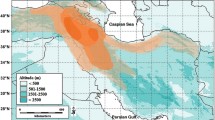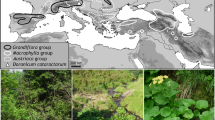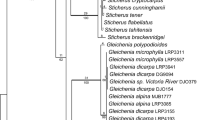Abstract
A total of 93 species of Hedysarum from diverse biogeographic regions, in particular from southwest Asia, were included in phylogenetic analyses using nuclear (ITS) and plastid DNA sequences (trnL–trnF and matK). Maximum likelihood and Bayesian analyses of combined plastid data retrieved Hedysarum as monophyletic, whereas phylogenetic analyses of the nuclear data inferred Hedysarum as non-monophyletic. In both datasets, Hedysarum comprised three distinct and well-supported clades corresponding to sections Hedysarum, Stracheya and Multicaulia. The latter section fell into two distinct lineages, taxonomically redefined as H. subsects. Multicaulia and Crinifera. Thus, our results did not support the monophyly of the three traditionally recognized subsections of Multicaulia. Furthermore, within H. subsect. Crinifera, several species groups were recognized. Bayesian divergence time estimation suggested that the initial radiation of Hedysarum and the subsequent divergence of its major clades started in the middle Miocene and extended into the Pliocene and Pleistocene. Based on the molecular phylogenetic results, an updated taxonomic treatment is provided for H. subsects. Multicaulia and Crinifera as well as for H. sect. Stracheya expanded to include H. tibeticum plus four species traditionally placed in H. subsect. Subacaulia. For species of H. sect. Stracheya, a determination key is given.






Similar content being viewed by others
References
Acosta MC, Premoli AC (2010) Evidence of chloroplast capture in South American Nothofagus (subgenus Nothofagus, Nothofagaceae). Molec Phylogen Evol 54:235–242. https://doi.org/10.1016/j.ympev.2009.08.008
Ahangarian S, Kazempour-Osaloo S, Maassoumi AA (2007) Molecular phylogeny of the tribe Hedysareae with special reference to Onobrychis (Fabaceae) as inferred from nrDNA ITS sequences. Iran J Bot 13:64–74
Akrami S, Mozaffarian V, Maassoumi AA, Nejadsattari T (2011) A new species of Hedysarum (Fabaceae) and a new record of Anemone (Ranunculaceae) from Iran. Iran J Bot 17:20–23. https://doi.org/10.22092/ijb.2011.101547
Amirabadi-zadeh H (2011) New records of Hedysareae (Papilionaceae) from Iran. Iran J Bot 17:63–68. https://doi.org/10.22092/ijb.2011.101591
Amirahmadi A, Kazempour-Osaloo S, Maassoumi AA (2010) Loss of chloroplast trnLUAA intron in two species of Hedysarum (Fabaceae): evolutionary implications. Iran J Biotechnol 8:150–155
Amirahmadi A, Kazempour-Osaloo S, Larti M (2013) A new interesting record of Hedysarum L. (Hedysareae, Fabaceae) from Northwest of Iran. Iran J Bot 19:29–31. https://doi.org/10.22092/ijb.2013.2989
Amirahmadi A, Kazempour-Osaloo S, Moein F, Kaveh A, Maassoumi AA (2014) Molecular systematics of the tribe Hedysareae (Fabaceae) based on nrDNA ITS and plastid trnL-F and matK sequences. Pl Syst Evol 300:729–747. https://doi.org/10.1007/s00606-013-0916-5
Bagheri A, Maassoumi AA, Rahiminejad MR, Brassac J, Blattner FR (2017) Molecular phylogeny and divergence times of Astragalus section Hymenostegis: an analysis of a rapidly diversifying species group in Fabaceae. Sci Rep 7:14033. https://doi.org/10.1038/s41598-017-14614-3
Bidarlord M, Ghahremaninejad F, Mozaffarian V (2015) Hedysarum persicum (Hedysareae, Leguminosae), a new species from Talesh Mountains. Iran. Phytotaxa 234:294–298. https://doi.org/10.11646/phytotaxa.234.3.11
Borchsenius F (2009) FastGap 1.2. Department of Biosciences, Aarhus University, Denmark. Available at: http://www.aubot.dk/FastGap_home.htm
Choi BH, Ohashi H (1996) Pollen morphology and taxonomy of Hedysarum and its related genera of the tribe Hedysareae (Leguminosae-Papilionoideae). J Jap Bot 71:191–213
Choi BH, Ohashi H (2003) Generic criteria and an infrageneric system for Hedysarum and related genera (Papilionoideae-Leguminosae). Taxon 52:567–576. https://doi.org/10.2307/3647455
Cunningham CW (1997) Can three incongruence tests predict when data should be combined? Molec Biol Evol 14:733–740. https://doi.org/10.1093/oxfordjournals.molbev.a025813
Degnan JH, Rosenberg NA (2009) Gene tree discordance, phylogenetic inference and the multispecies coalescent. Trends Ecol Evol 24:332–340. https://doi.org/10.1016/j.tree.2009.01.009
Dehshiri MM (2013) Hedysarum kalatense sp. nov. (Fabaceae) from Iran. Nordic J Bot 31:208–212. https://doi.org/10.1111/j.1756-1051.2012.01535.x
Dehshiri MM, Goodarzi MM (2016) Taxonomic notes on Hedysarum sect. Crinifera (Fabaceae) In Iran, with description of a new species. Ann Bot Fenn 53:21–26. https://doi.org/10.5735/085.053.0204
Dehshiri MM, Maassoumi AA, Zarrini M (2012) Hedysarum garinense sp. nov. (Fabaceae: Hedysareae) from Iran. Nordic J Bot 30:522–525. https://doi.org/10.1111/j.1756-1051.2011.01345.x
Djamali M, Baumel A, Brewer S, Jackson ST, Kadereit JW, López-Vinyallonga S, Mehregan I, Shabanian E, Simakova A (2012) Ecological implications of Cousinia Cass. (Asteraceae) persistence through the last two glacial–interglacial cycles in the continental Middle East for the Irano-Turanian flora. Rev Palaeobot Palynol 172:10–20. https://doi.org/10.1016/j.revpalbo.2012.01.005
Doyle JJ, Doyle JL (1987) A rapid DNA isolation procedure for small quantities of fresh leaf tissue. Phytochem Bull 19:11–15
Drummond AJ, Suchard MA, Xie D, Rambaut A (2012) Bayesian phylogenetics with BEAUti and the BEAST 1.7. Molec Biol Evol 29:1969–1973. https://doi.org/10.1093/molbev/mss075
Duan LJ, Wen JN, Yang X, Liu PL, Arslan E, Ertuğrul K, Chang ZY (2015) Phylogeny of Hedysarum and tribe Hedysareae (Leguminosae: Papilionoideae) inferred from sequence data of ITS, matK, trnL-F and psbA-trnH. Taxon 64:49–64. https://doi.org/10.12705/641.26
Edgar RC (2004) Muscle: multiple sequence alignment with high accuracy and high throughput. Nucl Acids Res 32:1792–1797. https://doi.org/10.1093/nar/gkh340
Farris JS, Kallersjo M, Kluge AG, Bult C (1995) Testing significance of incongruence. Cladistics 10:315–319. https://doi.org/10.1111/j.1096-0031.1994.tb00181.x
Favre A, Päckert M, Pauls SU, Jähnig SC, Uhl D, Michalak I, Muellner-Riehl AN (2015) The role of the uplift of the Qinghai-Tibetan Plateau for the evolution of Tibetan biotas. Biol Rev 90:236–253. https://doi.org/10.1111/brv.12107
Fedtschenko BA (1902) Generis Hedysari revisio. Acta Horti Petropolitani 19:183–342
Fedtschenko BA (1972) Hedysarum L. (Leguminosae). In: Komarov VL, Shishkin BK, Bobrov EG (eds) Flora of the U.S.S.R 13. Israel Program for Scientific Translations. Keter Press, Jerusalem, pp 199–243
Gardes M, Bruns TD (1993) ITS primers with enhanced specificity for basidiomycetes–application to the identification of mycorrhizae and rusts. Molec Ecol 2:113–118. https://doi.org/10.1111/j.1365-294X.1993.tb00005.x
Görür N, Sakinc M (1995) Miocene to Pliocene palaeogeographic evolution of Turkey and its surroundings. J Human Evol 28:309–324. https://doi.org/10.1006/jhev.1995.1025
Kumar S, Stecher G, Tamura K (2016) MEGA7: molecular Evolutionary Genetics Analysis Version 7.0 for bigger datasets. Molec Biol Evol 7:1870–1874. https://doi.org/10.1093/molbev/msw054
Lavin M, Herendeen PS, Wojciechowski MF (2005) Evolutionary rates analysis of Leguminosae implicates a rapid diversification of lineages during the Tertiary. Syst Biol 54:575–594. https://doi.org/10.1080/10635150590947131
Liu P-L, Wen J, Duan L, Arsalan E, Ertuğrul K, Chang Z-Y (2017) Hedysarum L. (Fabaceae: Hedysareae) is not monophyletic - evidence from phylogenetic analyses based on five nuclear and five plastid sequences. PLoS ONE 12:e0170596. https://doi.org/10.1371/journal.pone.0170596
Lock JM (2005) Tribe Hedysareae. In: Lewis G, Schrire B, Mackinder B, Lock JM (eds) Legumes of the World. Royal Botanical Gardens, Kew, pp 489–495
Miller MA, Pfeiffer W, Schwartz T (2010) Creating the CIPRES Science Gateway for inference of large phylogenetic trees. In: Proceedings of the Gateway Computing Environments Workshop (GCE), New Orleans, Louisiana. IEEE, Piscataway, pp 45–52. https://doi.org/10.1109/GCE.2010.5676129
Moghaddam M, Kazempour-Osaloo S, Hosseiny H, Azimi F (2017) Phylogeny and divergence times of the Coluteoid clade with special reference to Colutea (Fabaceae) inferred from nrDNA ITS and two cpDNAs, matK and rpl32-trnL(UAG) sequences data. Pl Biosyst 151:1082–1093. https://doi.org/10.1080/11263504.2016.1244120
Naderi-Safar K, Kazempour-Osaloo S, Maassoumi AA, Zarre S (2014) Molecular phylogeny of Astragalus section Anthylloidei (Fabaceae) inferred from nrDNA ITS and plastid rpl32-trnL(UAG) sequence data. Turk J Bot 38:637–652. https://doi.org/10.3906/bot-1308-44
Nafisi H, Kazempour-Osaloo S, Mozaffarian V, Amini-Rad M (2019) Hedysarum alamutense (Fabaceae-Hedysareae), a new species from Iran, and its phylogenetic position based on molecular data. Turk J Bot 43:386–394. https://doi.org/10.3906/bot-1806-50
Noroozi J, Akhani H, Breckle SW (2007) Biodiversity and phytogeography of the alpine flora of Iran. Biodivers Conserv 17:493–521. https://doi.org/10.1007/s10531-007-9246-7
Noroozi J, Talebi A, Doostmohammadi M, Rumpf SB, Linder HP, Schneeweiss GM (2018) Hotspots within a global biodiversity hotspot - areas of endemism are associated with high mountain ranges. Sci Rep 8:10345. https://doi.org/10.1038/s41598-018-28504-9
Nylander JAA (2004) MrModeltest v2. Program distributed by the author. Evolutionary Biology Centre, Uppsala University, Uppsala
Nylander JA, Wilgenbusch JC, Warren DL, Swofford DL (2008) AWTY (Are We There Yet?): a system for graphical exploration of MCMC convergence in Bayesian phylogenetics. Bioinformatics 24:581–583. https://doi.org/10.1093/bioinformatics/btm388
Polhill RM (1981) Papilionoideae. In: Polhill RM, Raven PH (eds) Advances in Legume Systematics, part 1. Royal Botanic Gardens, Kew, pp 191–208
Posada D, Buckley TR (2004) Model selection and model averaging in phylogenetics: advantages of Akaike information criterion and Bayesian approaches over likelihood ratio tests. Syst Biol 53:793–808. https://doi.org/10.1080/10635150490522304
Rambaut A, Drummond AJ, Xie D, Baele G, Suchard MA (2018) Posterior summarization in Bayesian phylogenetics using Tracer 1.7. Syst Biol 67:901–904. https://doi.org/10.1093/sysbio/syy032
Ranjbar M (2010) Two new species of Hedysarum (Fabaceae) from Iran. Novon 20:329–333. https://doi.org/10.3417/2008112
Ranjbar M, Karamian R, Johartchi MR (2006) Notes on the taxonomy of Hedysarum (Fabaceae) in Iran. Ann Bot Fenn 43:152–155
Ranjbar M, Karamian R, Olanj N (2007) A new species of Hedysarum (Fabaceae) in Iran and other new Hedysarum records. Bot J Linn Soc 155:505–512. https://doi.org/10.1111/j.1095.8339.2007.00716.x
Ranjbar M, Karamian R, Olanj N, Johartchi MR (2008) A key and four new species of Hedysarum (Fabaceae) in Iran. Nordic J Bot 26:10–20. https://doi.org/10.11646/phytotaxa.39.1.5
Rechinger KH (1952) Papilionaceae novae iranicae (Rechingeri iter irnaicum secundum –Nr. 15). Bot Jahrb Syst Pflanzengesch Pflanzengeogr 75:333–341
Rechinger KH (1984) Tribus Hedysareae. In: Rechinger KH (ed) Papilionaceae II, Flora Iranica 157:365–475. Akademische Druck- und Verlagsanstalt, Graz
Ronquist F, Teslenko M, van der Mark P, Ayres DL, Darling A, Höhna S, Larget B, Liu L, Suchard MA, Huelsenbeck JP (2012) MrBayes 3.2: efficient Bayesian phylogenetic inference and choice across a large model space. Syst Biol 61:539–542. https://doi.org/10.1093/sysbio/sys029
Sang T, Crawford DJ, Stuessy TF (1995) Documentation of reticulate evolution in peonies (Paeonia) using internal transcribed spacer sequences of nuclear ribosomal DNA: implication for biogeography and concerted evolution. Proc Natl Acad Sci USA 92:6813–6817. https://doi.org/10.1073/pnas.92.15.6813
Shahi-Shavvon R, Kazempour-Osaloo SH, Moharrek F, Karaman Erkul S, Lemmon AR, Moriarty Lemmon E, Michalak I, Muellner-Riehl AN, Favre A (2017) Increasing phylogenetic support for explosively radiating taxa: the promise of high-throughput sequencing for Oxytropis (Fabaceae). J Syst Evol 55:385–404. https://doi.org/10.1111/jse.12269
Shi W, Liu PL, Duan L, Pan BR, Su ZH (2017) Evolutionary response to the Qinghai- Tibetan Plateau uplift: phylogeny and biogeography of Ammopiptanthus and tribe Thermopsideae (Fabaceae). PeerJ 5:e3607. https://doi.org/10.7717/peerj.3607
Soltis DE, Kuzoff RK (1995) Discordance between nuclear and chloroplast phylogenies in the Heuchera group (Saxifragaceae). Evolution 49:727–742. https://doi.org/10.1111/j.1558-5646.1995.tb02309.x
Stamatakis A (2014) RAxML Version 8: a tool for phylogenetic analysis and post-analysis of large phylogenies. Bioinformatics 30:1312–1313. https://doi.org/10.1093/bioinformatics/btu033
Steele KP, Wojciechowski MF (2003) Phylogenetic analyses of tribes Trifolieae and Vicieae, based on sequences of the plastid gene matK (Papilionoideae: Leguminosae). In: Klitgaard BB, Bruneau A (eds) Advances in legume systematics, part 10, higher level systematics. Royal Botanic Garden, Kew, pp 355–370
Suchard MA, Weiss RE, Sinsheimer JS (2001) Bayesian selection of continuous-time Markov chain evolutionary models. Molec Biol Evol 18:1001–1013
Suchard MA, Weiss RE, Dorman KS, Sinsheimer JS (2003) Inferring spatial phylogenetic variation along nucleotide sequences: a multiple change-point model. J Amer Stat Assoc 98:427–437
Suchard MA, Weiss RE, Sinsheimer JS (2005) Models for estimating Bayes factors with applications to phylogeny and tests of monophyly. Biometrics 61:665–673
Swofford DL (2002) Phylogenetic analysis using parsimony (* and other methods). Version. 4. Sinauer Associates, Sunderland
Taberlet P, Gielly L, Pautou G, Bouvet J (1991) Universal primers for amplification of three non-coding regions of chloroplast DNA. Pl Molec Biol 17:1105–1109. https://doi.org/10.1007/BF00037152
Tavakkoli S, Kazempour Osaloo S, Mozaffarian V, Maassoumi AA (2015) Molecular phylogeny of Atraphaxis and the woody Polygonum species (Polygonaceae): taxonomic implications based on molecular and morphological evidence. Pl Syst Evol 301:1157–1170. https://doi.org/10.1007/s00606-014-1140-7
Wendel JF, Doyle JJ (1998) Phylogenetic incongruence: window into genome history and molecular evolution. In: Soltis DE, Soltis PS, Doyle JJ (eds) Molecular Systematics of Plants II: DNA Sequencing. Springer, Boston, pp 265–296
White TJ, Bruns T, Lee S, Taylor J (1990) Amplification and direct sequencing of fungal ribosomal RNA genes for phylogenetics. In: White T, Innis M, Gelfand D, Sninsky J (eds) PCR Protocols: A guide to methods and applications. Academic Press, San Diego, pp 315–322
Wicke S, Schneeweiss GM, de Pamphilis CW, Müller KF, Quandt D (2011) The evolution of the plastid chromosome in land plants: gene content, gene order, gene function. Pl Molec Biol 76:273–297. https://doi.org/10.1007/s11103-011-9762-4
Wojciechowski MF (2003) Reconstructing the phylogeny of legumes (Leguminosae): an early 21st century perspective. In: Klitgaard B, Bruneau A (eds) Advances in Legume Systematics, part 10. Royal Botanic Gardens, Kew, pp 5–35
Wojciechowski MF (2005) Astragalus (Fabaceae): a molecular phylogenetic perspective. Brittonia 57:382–396. https://doi.org/10.1663/0007-196X(2005)057
Wojciechowski MF, Sanderson MJ, Steele KP, Liston A (2000) Molecular phylogeny of the “temperate herbaceous tribes” of papilionoid legumes: a super tree approach. In: Herendeen P, Bruneau A (eds) Advances in legume systematics, part 9. Royal Botanic Garden, Kew, pp 277–298
Wojciechowski MF, Lavin M, Sanderson MJ (2004) A phylogeny of legumes (Leguminosae) based on analysis of the plastid gene resolves many well-supported subclades within the family. Amer J Bot 91:1846–1862
Xu LR, Choi BH (2010) Hedysarum (Fabaceae–Hedysareae). In: Wu ZY, Raven PH, Hong DY (eds) Flora of China 10. Science Press, Beijing, pp 514–525
Acknowledgements
We are grateful to Seher Karaman for preparing leaf samples of Turkey and Akram Kaveh for assisting in the laboratory and advising on methodology. Special thanks are given to Dr. E. Vitek, curator of Herbarium of Natural History Museum of Vienna, for his significant support in obtaining samples and helpful comments during the morphological studies and to Dr. D. Marshal from the University of Connecticut, for his noble comments in implementing phylogenetic analyses.
Author information
Authors and Affiliations
Corresponding author
Additional information
Handling Editor: Christoph Oberprieler.
Publisher's Note
Springer Nature remains neutral with regard to jurisdictional claims in published maps and institutional affiliations.
Electronic supplementary material
Below is the link to the electronic supplementary material.
Information on Electronic Supplementary material
Information on Electronic Supplementary material
Online Resource 1. Taxa included in the nrDNA ITS, trnL–F and matK analyses.
Online Resource 2. The aligned data matrix of the nrDNA ITS.
Online Resource 3. The aligned data matrix of the combined plastid regions (trnL–F, matK).
Rights and permissions
About this article
Cite this article
Nafisi, H., Kazempour-Osaloo, S., Mozaffarian, V. et al. Molecular phylogeny and divergence times of the genus Hedysarum (Fabaceae) with special reference to section Multicaulia in Southwest Asia. Plant Syst Evol 305, 1001–1017 (2019). https://doi.org/10.1007/s00606-019-01620-3
Received:
Accepted:
Published:
Issue Date:
DOI: https://doi.org/10.1007/s00606-019-01620-3




